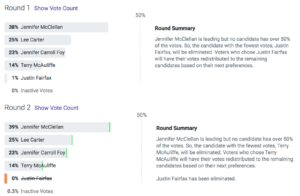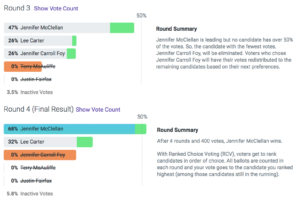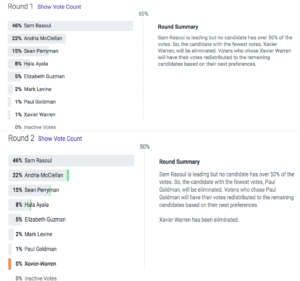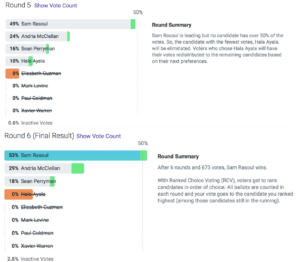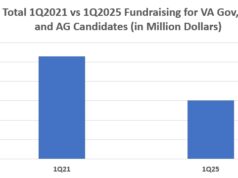by Cindy and Lowell
After the dumpster fire that is the Virginia GOP finally (?) settled on an unassembled convention for nominating their statewide candidates, Lowell and I realized that while the Democratic Party’s primary was more little-d democratic because it made it possible for every registered voter to participate, the unassembled convention did at least give their voters (the ones able to participate) the opportunity to express their full preferences by relying on rounds of voting similar to ranked choice voting. Which made us wonder, what would this year’s Democratic primaries look like if ranked choice voting were used?
In our enthusiasm, we decided to do some online polling. First challenge: finding a software tool online that was able to get the job done. We wanted it to be easy for users and not make any obstacles to voting (we are Democrats after all) like having to set up an account or visit another website, prevent or at least make some attempt to prevent repeat voting, and we wanted to be able to embed the poll in various platforms. That proved harder than expected, some versions frustrating us so much that we nearly abandoned the project. But we finally settled on rankit.vote, which while not perfect, was at least workable.
We ran the polls over the weekend, one poll asking voters to rank all the Lieutenant Governor candidates; and a second one asking them to rank the gubernatorial candidates. All told, 400 ranked-choice “ballots” were cast in the gubernatorial poll, and 673 in the Lieutenant Governor poll.
See below for pictures of the rounds of voting for the gubernatorial poll. You can see that in this race, Jennifer McClellan started out with a substantial lead over the rest of the field, with ranked choice voting helping her to reach a majority. As Justin Fairfax and then Terry McAuliffe were eliminated, the bulk of their votes were re-allocated mostly to Jennifer McClellan and Jennifer Carroll Foy, about proportionately to their original first round votes. When Jennifer Carroll Foy was eliminated, her votes were distributed to Jennifer McClellan and Lee Carter, with slightly more going to Lee Carter, but still giving Jennifer McClellan enough to go over the top. (Note that Jennifer McClellan was leading this poll all along, with Jennifer Carroll Foy in second, until a last second push for Lee Carter, because that’s how social media polls work.)
In the Lieutenant Governor poll, the social media maneuvering was even more dramatic. For most of the weekend, Andria McClellan was in the lead, with Sean Perryman in a very close second. But a last minute big bump from Sam Rasoul supporters flipped things around. In the final results, Sam Rasoul started out close to winning a majority of the vote. As candidates below him were eliminated one by one, their votes were mostly distributed evenly among the top vote-getting candidates. Ultimately it took six rounds for Rasoul to reach a majority of the vote.
Here are a few other things we learned:
- Online polling of this sort cannot really give reliable estimates of the true voting population, because some campaigns push their supporters and surrogates/staff to vote, while others ignore (silly) online polls. This was clearly the case in our polls, as evidenced by the number of “ballots” where the voter just “ranked” one candidate. (For example, while Sam Rasoul won the Lieutenant Governor’s poll and was ranked first in 311 ballots, in 159 of these he was the only candidate listed, and the voters did not rank any of the other candidates. While this might happen occasionally in real ranked choice elections, it wouldn’t be this frequent.)
- In an election with as many candidates as the Democratic primary for Lieutenant Governor has, many voters aren’t well enough informed to have preferences over the full set of candidates, and are only able to rank a handful. Of the 673 ballots in that race, 236 chose only one candidate (in addition to the 159 for Sam Rasoul, 48 only listed Andria McClellan, and 12 only listed Sean Perryman), 25 ranked only two, 68 ranked only three, 31 ranked four, 12 ranked five, 3 ranked six, and 2 ranked seven. But 296 ranked all eight–which is undoubtedly less a function of having full preferences over all eight, as of the system just being designed for voters to rank all eight.
- In the gubernatorial poll, we see similar results, with 26 ballots only listing Jennifer McClellan, 13 only listing Terry McAuliffe; and 8, 5, and 1 listing only Jennifer Carroll Foy, Lee Carter, and Justin Fairfax, respectively.
- One result we had expected to find, based on anecdotal reports we’ve seen of people saying they would vote for “one of the Jennifers,” but seeming not to have a strong preference between them, was that many people would rank Jennifer McClellan and Jennifer Carroll Foy in first and second place, in some order. While 94 ballots did list them in first and second place, other combinations for the top two spots were quite popular as well, including 79 ballots with Jennifer Carroll Foy and Lee Carter at the top (in either order), and 73 ballots with Jennifer McClellan and Terry McAuliffe at the top (in either order).
The bottom line is that, while it’s kinda fun to do online polling, there are too many inherent flaws to take it particularly seriously. And, as great as Ranked Choice Voting is, the free software for doing online polls using that method doesn’t really solve the problems, leaving us…basically, waiting for some more scientific, aka real polls of the Virginia 2021 statewide races.



